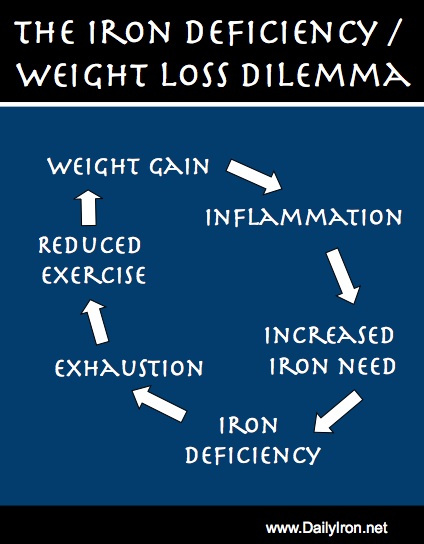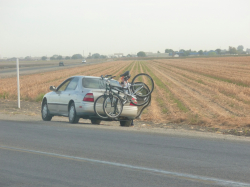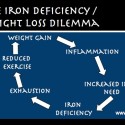My work on this iron site has slowed due to quite an ironic reason: I have been completely exhausted.
The cause? Iron deficiency.
Yes, IRONic even, as the author of this website on food iron.
As I struggle to crawl out of the pit, I realize more than ever some specific problems we may face as we try to get some of this important nutrient into our red blood cells where it belongs.
First, I am part of a growing demographic of the iron deficient: middle-aged overweight women. What researchers are beginning to realize is that the inflammation caused by our fat reduces our ability to get iron into our cells where it belongs.
Simply, being fat can aggravate (or even cause entirely) an iron deficiency.
So I sit here fluffy and iron deficient. If I can lose fat, I will solve my iron problem faster, but how in the heck can I lose fat if I am too exhausted to get off the couch?
The exhaustion associated with iron deficiency is epic, as you know well if you struggle with an iron deficiency. The idea of working out at the gym and on a calorie restricted diet is simply unrealistic. In my personal experience, we really need a more complex plan to solve our problem.
Weight Loss with an Iron Deficiency
First, losing weight really will help our battle. In one study on my little (or not so little) demographic, the weight loss solution the authors study is bariatric surgery. Bariatric surgery helped women lose weight, reduced the inflammation in their bodies, and actually positively impacted their iron status. (See the study.) Reducing inflammation also protected their hearts, brains, and really their entire bodies — all major diseases have some root in inflammation.
To clarify, I am not an advocate of bariatric surgery — it works for some people and it doesn’t work for others. For my purposes here, if there is any other way to lose, we ought to work on an alternative method. I would not judge anyone harshly (or even mildly) if they had such a surgery. You can find plenty of that judgment all over the Internet, so I figure that job is already overly-staffed.
The key point is that if we can reduce our fat, we will be at lower risk for coronary events, depression, and even iron deficiency.
The Problem of Exercising with an Iron Deficiency
 To lose fat in order to solve our iron problem, we have an immediate dilemma: We don’t have energy and we can’t push ourselves through an exercise program.
To lose fat in order to solve our iron problem, we have an immediate dilemma: We don’t have energy and we can’t push ourselves through an exercise program.
If you find yourself trying to exercise and wonder what is wrong — why you can’t push yourself through your exercise set or even walk a little bit further — you really aren’t going crazy. Iron deficiency directly affects our physical performance, beyond simply being tired.
I live at the top of a hill and, for years, part of my regular exercise has been walking down to the main road and back up. The “back up the road” was only ever a problem when I was 39 weeks pregnant with snow on the ground. Even then, I worked it out. At the peak of my epic exhaustion from iron deficiency, I could not even push myself through the walk.
Do you know that feeling in an exercise program when you push through and then build up day after day? Depending on your circumstances, that strategy may simply not be possible for you when you are iron deficient. It wasn’t for me.
As I see it, we face two dilemmas:
- How do we get to the point at which we can exercise (even a little bit) so that we can work on weight loss?
- Are calorie restrictions for weight loss even appropriate for someone with a nutritional deficiency?
For my own circumstances, I wondered if I should begin a calorie-restricted diet first to begin to lose and, thereby, improve my iron. However, at least in my case, I would have to restrict calories a I decided on a whole lot to lose without exercising. It’s not a good long-term strategy, especially in light of a mineral deficiency. I decided on a different path, not unlike that investigated in a clinical trial.
From the study, researchers confirm that we are not going crazy, it IS more difficult for us to exercise if you are iron deficient:
Evidence from both animal and human studies suggests that marginal deficiency reduces endurance capacity. Moreover, findings from animal studies also suggest that iron deficiency may impair training adaptation. Findings from human studies examining this relation are equivocal.
The researchers did something pretty simple: They gave a group of the women in their study iron supplements, a control group was given a placebo. Within six weeks, those women taking iron supplements had better physical endurance. (See the study.)
The idea is pretty simple: If we can take the edge off the iron deficiency, we can exercise better, and maybe then actually succeed in a more serious exercise regimen and even a weight loss program.
Phase 1: Focus First on the Iron, then Hit the Exercise
A deficiency will take months to correct, if not a good bit longer. It depends in part of why you are deficient. If the causes are simply dietary, diet changes and supplements could correct it in three months or so — the time in which your body actually makes a whole new set of blood cells, something it works on every day.
Middle aged women like myself may have changes in their cycles as they march toward menopause. Cycles can get heavier, causing regular loss of a lot of blood. Some people have metabolic problems that may be affecting their iron absorption.
Assuming you can get in front of why you are deficient and begin to solve it, your next step is to get your iron levels up enough that you can actually exercise.
How to Improve Your Iron Status?
As I’ve faced this iron problem, I have become extra diligent with my diet, using the various strategies I outline in the Iron Rich Foods digital book. However, I also spent the first six weeks of my program pounding on the iron problem with an iron supplement. I’ve recommended a liquid iron supplement on this site which is vegetarian and well-tolerated by most people. That may be a good option for you, but it is not actually the tool I used.
(In fact, there could be a host of reasons why your case is unique which is why it is important to work with your doctor. I know a lot about food but I am not a medical professional and certainly you need one who knows your individual case.)
If you’ve explored this website, you know that the best food source of iron is red meat and, more specifically, liver. I have taken an insane amount of desiccated liver (here) to combat this deficiency and I am happy to report that I can walk down and then back up our little hill. I went on a five-mile bike ride in the foothills and didn’t even have to stop for a nap in the middle of it.
Take an iron supplement that works for you, but I’ll explain a little bit more why liver is my choice in this instance.
As I said, liver is an excellent source of iron. Furthermore, liver may give us some energy, over and above that we might expect from its nutrient profile. There was actually a study back in the 50s of mice fed liver and they were actually more energetic. The field of “liver eating research” didn’t really continue after that, but I do find from personal experience that I get an energy boost from liver. Eating it fresh is best for my energy but I simply cannot eat it week after week in a recovery program like this. It is not a sustainable choice for me — I get tired of it quickly. When I do tire of it, there is the desiccated liver. If you do eat it fresh, definitely buy only organic liver from a good source.
For my desiccated liver, I used a supplement sourced from Argentina. Argentine beef tends to be grass fed, making the supplement a good quality. Desiccated liver is de-fatted so some of the toxins you may find in this meat are lost with the fat removal. I use a brand whose market is weight lifters hoping to dose a whole lot of iron as part of their muscle-building program. These guys take insane amounts of iron in their training — the supplement they use is perfect for me as well. It is priced for mega-dosing. (Also perfect.)
The best deal on the supplement is at either Amazon or Vitacost (considering shipping is free), priced at about $40 for 500 tablets. (Here at Amazon or at Vitacost.) The Vitacost deal is best if you buy something else and qualify for free shipping. I receive mine in two days. Amazon may work better for you. (Both of those links are referral links and this site receives a small commission if you buy from those vendors.)
In my regimen, I took a whopping 18 tablets a day (6 tablets 3 times a day) for three weeks, all before about 2 p.m. In my experience, liver tablets give me energy in a good way but they can also disturb my sleep if I take them too late in the day.
After three weeks, I reduced my intake to 12 tablets a day, still a whole lot of desiccated liver.
In the first month, I used nearly a whole bottle of those liver tablets I linked to above, for a cost of $41. Taking 12 a day, the cost is about $30 per month.
This is a fairly inexpensive intervention in the grand scheme of things.
After six weeks of this I was able to take that walk and bike ride that I mentioned above.
Phase 2: Once You Can Exercise, Begin Your Weight Loss
Phase 1 was actually pretty easy: pop pills. ![]() I am now in the difficult and yet great phase of having enough energy to move my body. The weight loss program begins.
I am now in the difficult and yet great phase of having enough energy to move my body. The weight loss program begins.
I am not a weight loss guru by any means. If you have a program that works for you, this would be the time to employ it. Based on my life-long experience with weight loss, I have the old-fashioned view that calorie reduction and added exercise is my best strategy. I don’t go on fad diets or restrict my diet completely to a single food group — the old-fashioned method works for me.
I do find that a “diet” takes a good bit of focus and energy — I have to make a lot of room in my life for my dieting. I don’t start one in the middle of a life crisis or life change. I reduce my work schedule as well.
 As I begin the dieting and exercise phase, I continue to take the desiccated liver. It gives me iron but, as I mentioned, it seems to give me an additional energy boost. On a calorie-restricted diet, you need any energy boost you can get, especially if you are still teetering on the edge of an iron deficiency. The desiccated liver helps. Your other iron supplement of choice may help as well.
As I begin the dieting and exercise phase, I continue to take the desiccated liver. It gives me iron but, as I mentioned, it seems to give me an additional energy boost. On a calorie-restricted diet, you need any energy boost you can get, especially if you are still teetering on the edge of an iron deficiency. The desiccated liver helps. Your other iron supplement of choice may help as well.
At this point, I’d love to report that I lost 50 pounds (or more!) and that it was all marvelously easy. As it is, I just rode a bike 5 miles in the foothills and walked up a hill, so I cling to that short-term success. I’m now ready for the rest and I will report back. (That’s my car cruising around central California as I hope to grab a bit of exercise.)
If you have comments or suggestions on any phase of our physical transformations, please leave it here.
